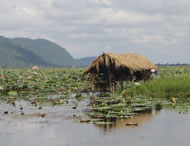The diversity of life on Earth is dramatically affected by human alterations of ecosystems, but compelling new evidence now shows that the reverse is also true: biodiversity in the broad sense affects the properties of ecosystems and, therefore, the benefits humans obtain from them. Human societies have been built on biodiversity. Many activities indispensable for human subsistence lead to biodiversity loss and this trend is likely to continue.
We clearly benefit from the diversity of organisms we have learned to use for medicines, food, fibres and other renewable resources. In addition, biodiversity has always been an integral part of the human experience, and there are many moral reasons to preserve it for its own sake. What has been less recognised is that biodiversity also influences human wellbeing, including access to water and basic materials for a satisfactory life, and security in the face of environmental change, through its effects on the ecosystem processes that lie at the core of the Earth’s most vital life-support systems.
Three recent publications from the Millennium Ecosystem Assessment (an initiative involving more than 1,500 scientists from all over the world) provide an updated picture of the fundamental messages and key challenges regarding biodiversity at the global scale. Chief among the findings are that human-induced changes in land cover at the global scale lead to clear losers and winners among species in biotic communities; that these changes have large impacts on ecosystem processes and thus on human wellbeing; and that such consequences will be felt disproportionately by people already living in poverty, who are the most vulnerable to the loss of ecosystem services.
As a consequence of global change drivers such as climate, biological invasions and especially land use, not only is the total number of species on the planet decreasing, but there are also losers and winners. On average, the organisms that are losing out have longer lifespans, bigger bodies, poorer dispersal capacities, more specialised resource use, lower reproductive rates, and other traits that make them more susceptible to human activities such as nutrient loading, harvesting, biomass removal by burning, livestock grazing, ploughing and clear-felling. A small number of species with the opposite characteristics are becoming increasingly dominant around the world.
The most dramatic examples of effects of small changes in biodiversity on ecosystem services have occurred at the landscape level and have involved alterations of food-web diversity through indirect interactions and trophic cascades. Most of these have been ‘natural experiments’: that is, the unintended consequence of intentional or accidental removal or addition of a certain predator, pathogen, herbivore or plant species to ecosystems. These ‘ecological surprises’ usually involve disproportionately large, unexpected, irreversible and negative alterations of ecosystem services, with large environmental, economic and cultural losses. Examples include the cascading effects of decreases in sea otter population that led to coastal erosion in the North Pacific, and a marked decrease in grassland productivity and nutritional quality in the Aleutian Islands as a consequence of decreased nutrient flux from the sea by the introduction of Arctic foxes.
People who rely most directly on ecosystem services, such as subsistence farmers and the rural poor, and traditional societies, face the most serious and immediate risks from biodiversity loss. First, they are the ones who rely most on the ‘safety net’ provided by the biodiversity of natural ecosystems in terms of food security and sustained access to medicinal products, fuel construction materials and protection from natural hazards such as storms and floods. Second, because of their low economic and political power, the less privileged sectors cannot substitute purchased goods and services for the lost ecosystem benefits and they typically have little influence on national policy.
When the quality of water deteriorates as a result of fertiliser and pesticide loading by industrial agriculture, the poor are unable to purchase safe water. When the protein and vitamins from local sources such as hunting and fruit decrease as a result of habitat loss, the rich can still purchase them, whereas the poor cannot. When the capacity of natural ecosystems to buffer the effects of storms and floods is lost because of coastal development, it is usually the people who cannot flee – for example, subsistence fishermen – who suffer the most.
In summary, the loss of biodiversity-dependent ecosystem services is likely to accentuate inequality and marginalisation of the most vulnerable sectors of society by decreasing their access to basic materials for a healthy life and by reducing their freedom of choice and action.Economic development that does not consider effects on these ecosystem services may decrease the quality of life of these vulnerable populations, even if other segments of society benefit. Biodiversity change is therefore inextricably linked to poverty – the largest threat to the future of humanity identified by the United Nations. This is a sobering conclusion for those who argue that biodiversity is simply an intellectual preoccupation of those whose basic needs and aspirations are fulfilled.
This article is an abridged version of a paper entitled Biodiversity Loss Threatens Human Well-Being by Sandra Díaz, Joseph Fargione, F. Stuart Chapin III & David Tilman. For the full article, contact Sandra Díaz, Professor of Ecology ([email protected]).







